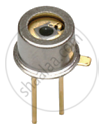Advertisements
Advertisements
Question
Write notes on the photodiode.
Solution

Circuit symbol

Schematic view of photodiode
- Photodiode is a p-n junction diode that converts an optical signal into electric current.
- It works in reverse bias.
- It consists of an F p-n junction semiconductor made of photosensitive material kept safely inside a plastic case.
- It has a small transparent window to allow light.
- When photon (hv) strikes depletion region of diode some valence band electrons elevated to conduction band. In turn, holes are developed in the valence band. This creates electron-hole pair.
- Amount of electron-hole pairs generated depends on the intensity of light.
- These electrons and holes swept across the junction by the electric field. Thus holes move to the n side, electrons to the p side.
- When an external circuit is made, electrons flow through an external circuit and constitute the photocurrent.
Applications:
Alarm system, count items in the conveyer belt, photoconductors, CD players, smoke detectors, detectors for computed tomography, etc.
APPEARS IN
RELATED QUESTIONS
In an unbiased p-n junction, the majority of charge carriers (that is, holes) in the p-region diffuse into the n-region because of
A diode is called a unidirectional device. Explain.
Distinguish between avalanche breakdown and Zener breakdown.
Write a short note on diffusion current across the p-n junction.
What is meant by biasing?
Define barrier potential.
List the applications of light emitting diode.
Draw the circuit diagram of a half wave rectifier and explain its working.
Explain the formation of depletion region and barrier potential in PN junction diode.
Explain the working principle of a solar cell. Mention its applications.
